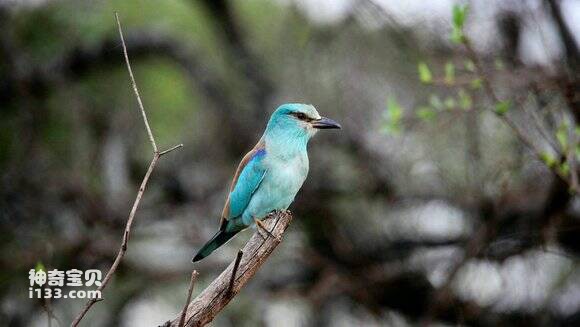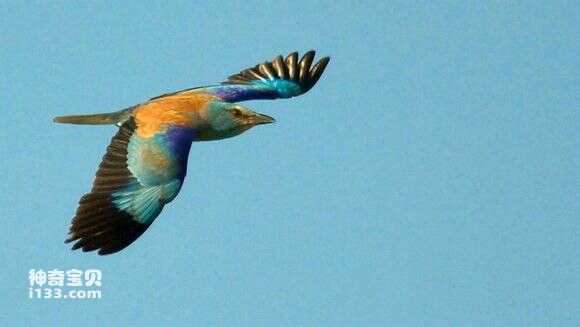Coracias garrulus
IUCN
LCBasic Information
Scientific classification
- name:Coracias garrulus
- Scientific Name:Coracias garrulus,European Roller
- Outline:Climbing birds
- Family:
Vital signs
- length:30-35.2cm
- Weight:Around 183g
- lifetime:No textual research information is available
Feature
Distribution and Habitat
Place of origin: Afghanistan, Albania, Algeria, Angola, Armenia, Austria, Azerbaijan, Bahrain, Belarus, Benin, Botswana, Bulgaria, Burkina Faso, Burundi, Cameroon, Central Africa, Chad, China, Congo (Burkina Faso), Cote d 'Ivoire, Croatia, Cyprus, Czech Republic, Djibouti, Egypt, Eritrea, Esani Asia, Ethiopia, France, Gabon, Gambia, Georgia, Germany, Ghana, Gibraltar, Greece, Guinea-Bissau, Hungary, India, Iran, Iraq, Israel, Italy, Jordan, Kazakhstan, Kenya, Kuwait, Kyrgyzstan, Latvia, Lebanon, Lesotho, Libya, Lithuania, Macedonia, the former Yugoslavia, Malawi, Mali, Malta, Mauritania, Moldova, Montenegro, Morocco, Mozambique, Namibia, Niger, Nigeria, Oman, Pakistan, Poland, Portugal, Qatar, Romania, Rwanda, Saudi Arabia, Senegal, Serbia, Slovakia, Slovenia, Somalia, South Africa, South Sudan, Spain, Sudan Eswatini, Syria, Tajikistan, Tanzania, Tunisia, Turkey, Turkmenistan, Uganda, Ukraine, United Arab Emirates, Uzbekistan, Western Sahara, Yemen, Zambia, Zimbabwe.
In China,
Appearance
The head, neck and underbody of the adult bird are pale blue, and the throat and foreneck pinnacles are white or dark blue-green. The abdomen is lighter than the chest. Shoulders, back and inner wings sandy or reddish brown, waist blue-purple. The tail is covered with blue-green feathers, the central tail feathers are also blue-green, the rest of the tail feathers are blue on the outside base, black on the inside base, bright light blue at the end, and the outermost tail feathers have black pinnules. The base of the small cover and the inner fly feathers are bright blue, and the rest are black.
The young are dark in color, with a sand-colored throat and breast, and white pinnacles.
Pale brown iris, dark brown mouth, pale brown feet.
Size measurement: weight 183 grams; The body length is 300~352 mm, ♀320~342 mm; Rostral peak 30~35 mm; Wings are 180~208 mm, ♀181~207 mm; Tail length 122-135 mm; Tarsus 30 to 35 mm. (Note: ♂ males; ♀ female)
Details
The blue-chested Buddhist monk is known as Coracias garrulus or European Roller, and has two subspecies。

Blue-chested Buddhas often work alone or in pairs. Many fly in the air to hunt, but also to the ground to hunt food. Rest on dead branches or wires. It feeds on invertebrates such as beetles, crickets, locusts, caterpillars, flies and spiders, as well as a few larger animals such as frogs, mice, lizards, snakes and emaciated small birds. It is customary to stand on high places such as tree trunks or power lines for a long time, searching for potential prey on the ground, and often following the plows that turn up the soil and eat.
The call of the blue-chested Buddhist monk is a gruff chack-ack, with the accent on the first syllable, like a jackdaw or magpie. Also known as the rrak-rrak, rrak-rehhh sound. It's a summer migrant. It can migrate long distances between continents, flying 10,000 kilometers from breeding grounds in Europe and Asia to sub-Saharan Africa, repeating the journey in the spring. In early April, a particularly spectacular migration of migratory birds can be observed in Africa, with countless blue-breasted Buddhas flying north along the narrow coastline from Tanzania to Somalia.

The breeding season of blue-chested Buddhist monks is from May to July. Mates help each other to defend their common breeding territory, usually nesting in steep river banks, gullies and cliff wall holes within the territory, but also in forest areas and forest edge holes in trees, and even in cracks in houses. They often breed together in small groups. The nest has no inner cushion and lays eggs directly on the ground. One clutch lays 1~7 eggs, 4 or 5 eggs are the most common, white, oval, the size of 33.3~39.0 mm ×26~30 mm, the average 35.9 mm ×28.0 mm. Male and female incubate eggs in turn (mainly by the female bird responsible for incubation), incubation period of 17 to 19 days, the chicks late sex, after hatching can not see things, but the development of fast, 25 to 30 days after the feathers grow to fly away from the nest; But still fed by the parent bird for three weeks or more.
Blue-breasted Buddhas became extinct in Germany, Denmark, Sweden, and Finland in the 20th century, possibly due to habitat loss due to intensive agriculture. Populations in the Middle East and Central Asia have not declined significantly. Over the past decade (1995-2005), the global total may have fallen by 20-30%.

In August 2022, the Qinghai Provincial Forestry and Grass Bureau announced at the provincial bird protection and management press conference that the "three protected animals" blue-chest Buddhist monks are rare and rare bird species with records but no video records in Qinghai.
Listed in Appendix II of the Convention on the Conservation of Migratory Species of Wild Animals (CMS).
Listed on The IUCN Red List of Threatened Species: Not Threatened (LC), 2015 assessment.
It was included in the List of Beneficial Terrestrial Wildlife under State Protection or of Important economic and scientific research Value issued by the State Forestry Administration of China on August 1, 2000. (Note: No. 275 Blue-chested Buddha)
Protect wild animals and eliminate wild meat.
Maintaining ecological balance is everyone's responsibility!








